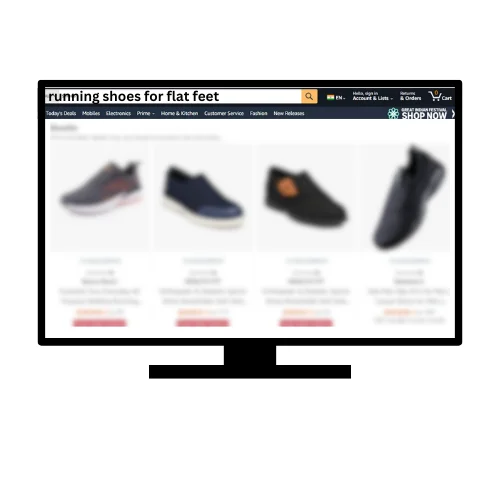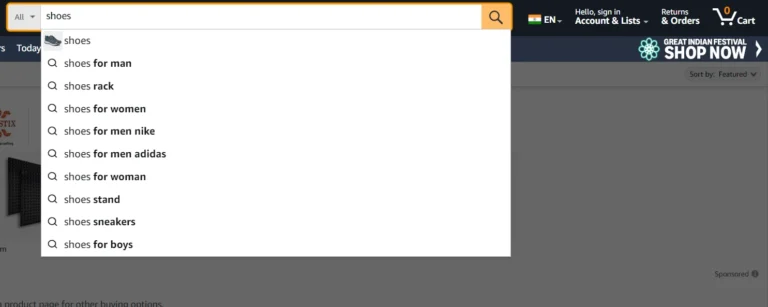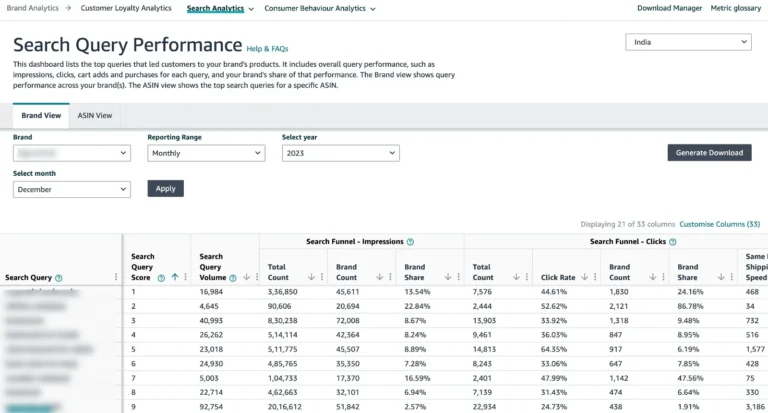Imagine you’ve just listed a range of products on Amazon. You’ve spent hours of your valuable time taking stunning photos of your product, and writing impactful descriptions of your product, and you are prepared to make the sale. Only after days or weeks of the campaign you realize that the sales never came in as expected.
What’s going wrong?
One reason could be that shoppers simply aren’t seeing your products. Effective Amazon keyword research can make all the difference. By identifying the terms customers are searching for, you can tailor your listings to be more visible, ultimately driving more sales.
In this guide, we’ll cover:
How to conduct Amazon keyword research to help customers easily find your products.
Practical strategies for selecting and integrating keywords into your product listings.
Tools and methods to discover high-performing keywords.
What do you need to know about Amazon keyword research?

Amazon keyword research is the study of the exact word choices that Amazon customers type into the search bar. This research is important to fine-tune your product listing and ensure it gets to the right search results.
Just like meeting the other half, it means going straight to the head of your customers and mirroring their approach towards your product titles, descriptions and backend search terms. It’s about dominating the given category, or being at the top of their field when they are looking for your product.
Why Do Keywords Matter on Amazon?
Keywords therefore are a way of linking the sellers and the buyers. For instance, if a customer enters a word or phrase in the search bar on Amazon, the website shows products that contain the keywords entered. In this case, if your listings have adopted the appropriate keywords, your product stands a better shot at being in the search list.
Without proper keyword research, your products might never reach your target audience. Even if they’re perfectly suited to customer needs, people can’t buy what they don’t see.
Amazon Keyword Research; Its Advantages and Users.
Customers: Consumers can easily identify sellers that offer products that fit their preferences.
Small businesses and individual sellers: Proper keyword research can help small sellers stand out by targeting less competitive keywords or niche markets.
Large brands: Keyword research helps them maintain visibility and adapt to trending search terms.
Resellers: They can use the keywords to make their listings stand out from other sellers who are selling the exact same products by targeting primary calls to action.
Types of Amazon Keywords
There are different types of keywords to consider, and each has a specific role in improving visibility:
Short-Tail Keywords

Short-tail keywords are broad, general keyword phrases that are usually only one or two words long, such as ‘shoes,’ and ‘laptop. These keywords are highly searched by customers. They are primarily used on the first level to generate maximum impressions.
Long-Tail Keywords

Long-tail keywords are keywords and phrases that are more unique and longer than standard keywords such as ‘running shoes for flat feet’ or ‘best lightweight laptop for graphic design’. While they produce fewer keyword searches, they are less saturated with competition, thus easier to rank higher and sell to a great target market that specifically knows what they want.
Branded Keywords

The other form of keywords is called branded keywords which are actually the name of the brand or the product such as the Nike running shoe or Apple MacBook. If your brand is recognizable, these will contribute to bringing in repeat customers to your business.
Non-Branded Keywords

These do not represent a specific brand or model, like, “wireless headphones” or “modern office ergonomic chair”. They assist in reaching those customers who intend to buy a certain kind of product as opposed to a definite product from a certain company.
Amazon Keyword Research Tools
There are several tools that you can use to identify the proper keywords for your products. Let’s take a look at some of the most effective options:
Amazon Search Bar

The search bar is one of the most basic, yet effective inventions of Amazon. When customers start typing a keyword then the application will automatically show the options based on the most frequent searches. Such auto-complete suggestions are beneficial to discover what trends today as search terms.
Amazon Product Opportunity Finder
This tool gives information on the current trends for particular products and terms, so you can measure interest and competition. It is a good way to seek out new specialized markets and see which keywords are frequently used by customers.
Search Queries with Performance of Amazon Ranking

Available through Amazon Brand Analytics, this tool allows you to analyze customer search behaviour, impressions, clicks, and buys. You can pinpoint the terms that connect customers to your listings and refine your keyword strategy accordingly.
Helium 10

Helium 10 offers a suite of tools to help with keyword research. Their “Cerebro” tool lets you see which keywords top competitors use. The “Magnet” tool provides keyword suggestions based on a seed keyword—a basic, broad term used as a starting point in keyword research to generate more specific, related keywords. These tools help you find both short-tail and long-tail keywords, making it easier to optimize the listings and attract more customers.
Helium 10 offers a free plan for limited access to its tools and access to more advanced features with a subscription.
Jungle Scout
You can track the trends, and see what competitors are doing by using Jungle Scout’s Keyword Scout which comes with data on search volume and competition.
For some reason, using Google’s search engine as a reference is not that unwise. Google suggestion and other related Google searches can show you keywords most searched in the Google search engine, which you can incorporate into your Amazon listings.
Implementing an Amazon Keyword Strategy
A successful keyword strategy is broken down into three stages: research, placement and performance evaluation.
1. Keyword Research
Begin with selecting the proper keywords for your products with the help of the tools listed above. Some key phrases may be called “golden” because none of your competitors uses them, but they have a pretty close relation to the products you offer.
2. Keyword Placement
The correct positioning of keywords in various sections of your Amazon product listing increases the product’s visibility and its ranking on the site. Here’s how to do it strategically:
Product Title
Your product title is the most important factor for Amazon and for your consumers, do not underestimate it. When in writing, it has to be brief, easy to understand, and unambiguous. Make sure your primary keyword is included in the title insert it naturally so that when people read the title they do not get a feeling that it has been forced in. Do not use this technique by repeating the keywords in the title because it gives off an unnatural look and is barely readable. An ideal composition of titles demands an amalgamation of the product dimensions such as size, material, hue and model.
Example: Men’s lightweight running shoes is a clean title that directly includes the key word ‘Lightweight Running Shoes’ in the title. While the text contains keywords, which let search engines understand what the page is all about, it tells the customer explicitly what the product is.
Bullet Points
Listings are the way to go because they help you stress certain aspects of your product – aspects such as your product’s unique selling proposition and value. This is where you explain the important functions as well as materials, use or look of the product. When placing keywords here, use those that bear the gain or loss brought about by the product in question. However, the text is easy to read and understand, and the authors have not resorted to using any unpardonable twists that can only accommodate such keywords.
Example: If you are selling running shoes, a bullet point could be: Breathable fabric for long-distance running—although the potential reader instantly knows the main benefit of the product (breathable fabric), there is a keyword related to running (long-distance running).
Product Description
Basically, a product description allows for elaborating on bullet points and offering customers a more detailed product preview. Here, you should include keyword phrases, which are longer and more descriptively used by clients at the final stages of the purchase decision. Often these keywords can define such narrow customer needs or describe the benefits of the product in more detail. You can also use this space to elaborate on the features, benefits, and uses of the product.
Example: In a product description for running shoes, you could say: These men’s lightweight running shoes feature a flexible, durable sole perfect for long-distance training. Designed to offer maximum comfort and breathability, they’re ideal for marathon runners and casual joggers alike. In this case, long-tail keywords such as “lightweight running shoes for long-distance training” and “shoes for marathon runners” help increase discoverability while addressing the customer’s needs.
Backend Search Terms
In backend search terms, you can type in any specific words that wouldn’t fit in an actual title, bullet points or description. This is a good chance to enter the closings, synonyms or other spelling variants that the customers might enter in a search query. However, avoid using the same keyword multiple times or incorporating trendy buzzwords that don’t directly relate to your product.
Tip: Avoid keyword stuffing or repetitive terms in the backend search terms. Instead, focus on new keywords that haven’t already been used in other sections to maximize your listing’s reach.
Key Word Sensor
Track how well your keywords perform using metrics like impressions, clicks, and conversions:
The Search Catalog Performance Dashboard can be used to check which keywords lead to traffic to the listings.
Check with customers to know what terms and features appeal to them when considering a purchase.
It is highly advisable to change this keyword often in accordance with current trends and seasonal variations.
Conclusion:
Amazon keyword research remains critical for any seller who wants to optimize his products to generate more sales. So if you know how your customers are searching and what tools they are using, you can make it easier for them to find your products when you apply a proper and smart approach. That’s why having the right keyword is important; you’re likely to attract the right kind of customer and the possibilities of selling to that customer are high.
Additional Reading
For more insights into optimizing your Amazon business, check out:

